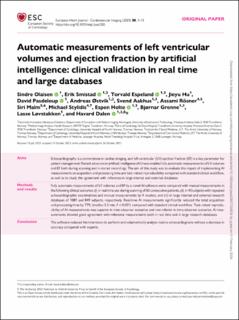| dc.contributor.author | Olaisen, Sindre Hellum | |
| dc.contributor.author | Smistad, Erik | |
| dc.contributor.author | Espeland, Torvald | |
| dc.contributor.author | Hu, Jieyu | |
| dc.contributor.author | Pasdeloup, David Francis Pierre | |
| dc.contributor.author | Østvik, Andreas | |
| dc.contributor.author | Aakhus, Svend | |
| dc.contributor.author | Rösner, Assami | |
| dc.contributor.author | Malm, Siri | |
| dc.contributor.author | Stylidis, Michael | |
| dc.contributor.author | Holte, Espen | |
| dc.contributor.author | Grenne, Bjørnar Leangen | |
| dc.contributor.author | Løvstakken, Lasse | |
| dc.contributor.author | Dalen, Håvard | |
| dc.date.accessioned | 2024-02-05T10:22:01Z | |
| dc.date.available | 2024-02-05T10:22:01Z | |
| dc.date.created | 2023-10-31T22:00:00Z | |
| dc.date.issued | 2023 | |
| dc.identifier.citation | European Heart Journal-Cardiovascular Imaging. 2023, . | en_US |
| dc.identifier.issn | 2047-2404 | |
| dc.identifier.uri | https://hdl.handle.net/11250/3115539 | |
| dc.description.abstract | Aims
Echocardiography is a cornerstone in cardiac imaging, and left ventricular (LV) ejection fraction (EF) is a key parameter for patient management. Recent advances in artificial intelligence (AI) have enabled fully automatic measurements of LV volumes and EF both during scanning and in stored recordings. The aim of this study was to evaluate the impact of implementing AI measurements on acquisition and processing time and test–retest reproducibility compared with standard clinical workflow, as well as to study the agreement with reference in large internal and external databases.
Methods and results
Fully automatic measurements of LV volumes and EF by a novel AI software were compared with manual measurements in the following clinical scenarios: (i) in real time use during scanning of 50 consecutive patients, (ii) in 40 subjects with repeated echocardiographic examinations and manual measurements by 4 readers, and (iii) in large internal and external research databases of 1881 and 849 subjects, respectively. Real-time AI measurements significantly reduced the total acquisition and processing time by 77% (median 5.3 min, P < 0.001) compared with standard clinical workflow. Test–retest reproducibility of AI measurements was superior in inter-observer scenarios and non-inferior in intra-observer scenarios. AI measurements showed good agreement with reference measurements both in real time and in large research databases.
Conclusion
The software reduced the time taken to perform and volumetrically analyse routine echocardiograms without a decrease in accuracy compared with experts. | en_US |
| dc.language.iso | eng | en_US |
| dc.publisher | Oxford University Press | en_US |
| dc.rights | Navngivelse-Ikkekommersiell 4.0 Internasjonal | * |
| dc.rights.uri | http://creativecommons.org/licenses/by-nc/4.0/deed.no | * |
| dc.title | Automatic measurements of left ventricular volumes and ejection fraction by artificial intelligence: clinical validation in real time and large databases | en_US |
| dc.title.alternative | Automatic measurements of left ventricular volumes and ejection fraction by artificial intelligence: clinical validation in real time and large databases | en_US |
| dc.type | Peer reviewed | en_US |
| dc.type | Journal article | en_US |
| dc.description.version | publishedVersion | en_US |
| dc.source.pagenumber | 13 | en_US |
| dc.source.journal | European Heart Journal-Cardiovascular Imaging | en_US |
| dc.identifier.doi | 10.1093/ehjci/jead280 | |
| dc.identifier.cristin | 2190780 | |
| dc.relation.project | Norges forskningsråd: 10.1093/ehjci/jead280 | en_US |
| cristin.ispublished | true | |
| cristin.fulltext | original | |
| cristin.qualitycode | 2 | |

